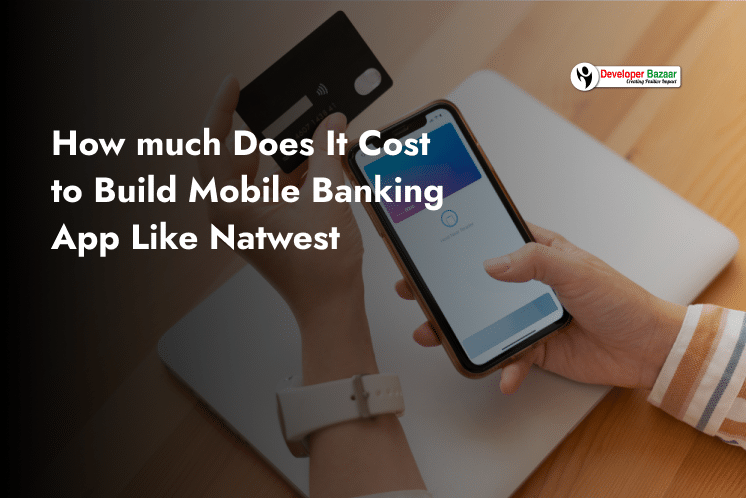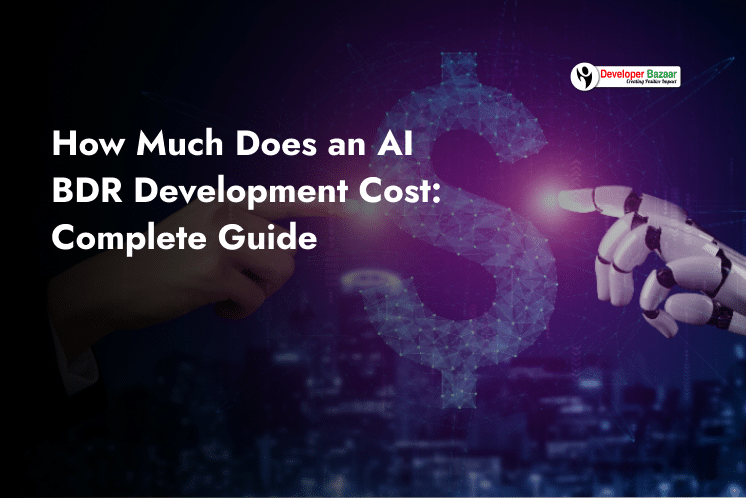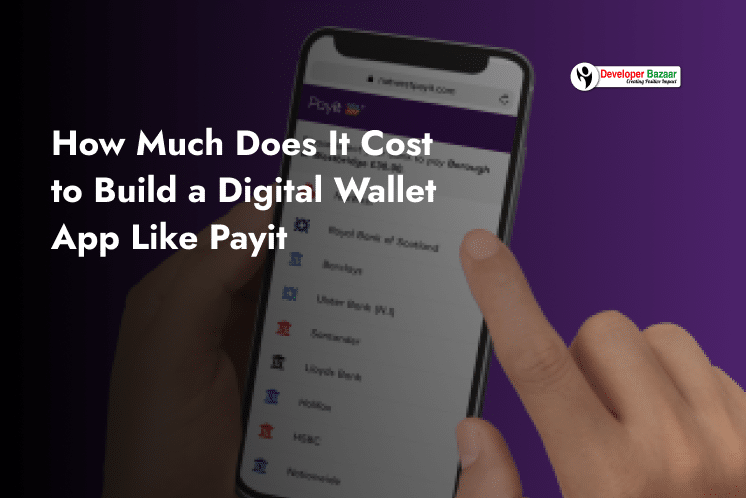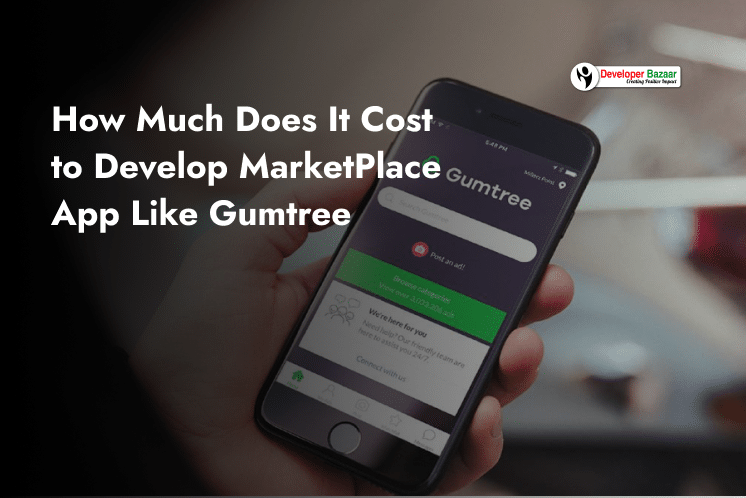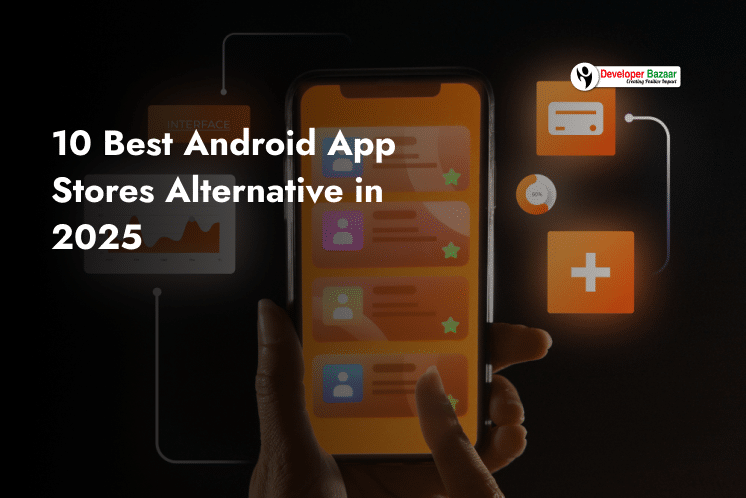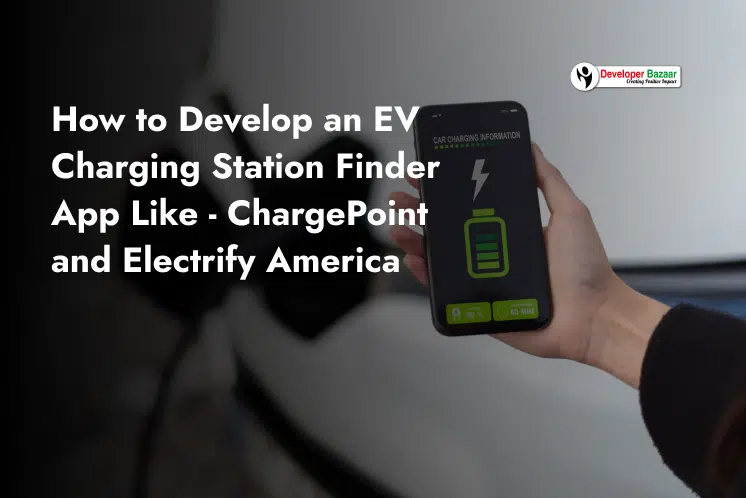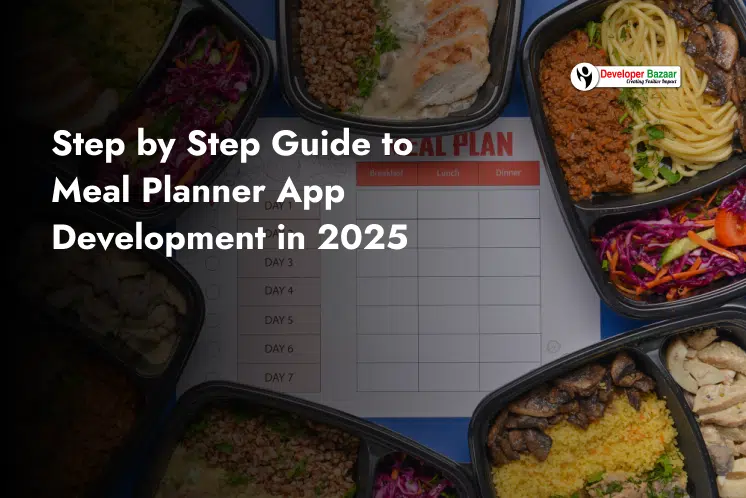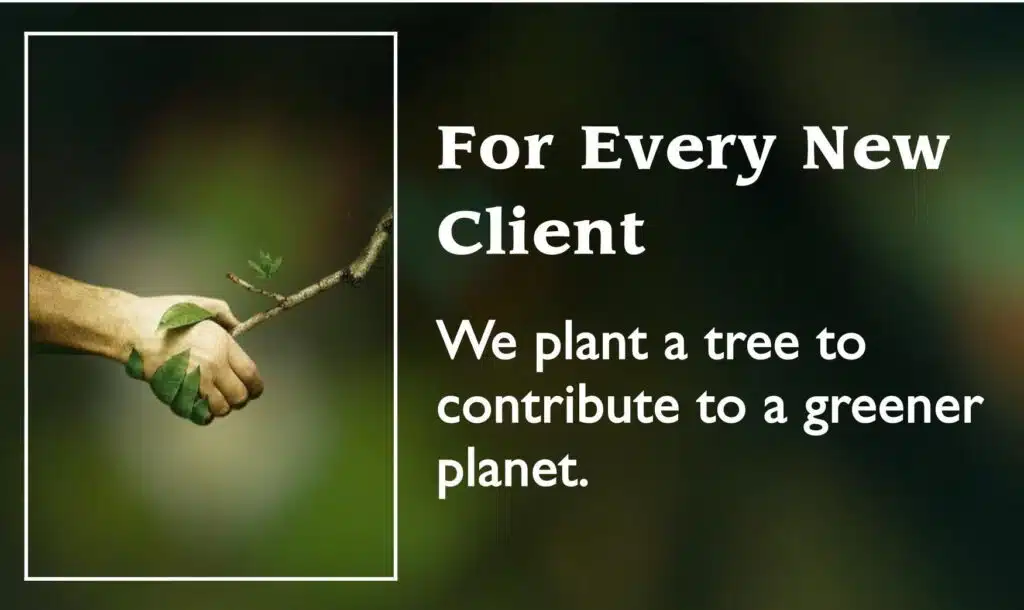Table of Contents
ToggleThinking of building your own logistics app like Porter? In that case you’re not the only one. As the online transportation system continues to increase, many entrepreneurs are exploring this growing space.
With more people moving and businesses depending on delivery services, the demand for reliable logistics solutions is surging.
Now is the best time to develop a logistics service app like Porter. This guide will explore you through the process to create a logistics service app like Porter, including essential features, challenges, and the cost to develop an app like Porter.
Whether you’re a startup or an enterprise, this article is your roadmap to build a logistics service app that delivers real value.
Key Statistics for Current Logistics Market
The logistics industry is expanding faster than ever, presenting new opportunities for growth and innovation.
In 2023, the global transportation market was valued at $10.2 trillion, and it’s projected to reach an impressive $16.79 trillion by 2032.
In the United States alone, the packers and movers sector employs approximately 122,600 people and generates $3.6 billion in wages annually. Interestingly, Americans relocate an average of 11.7 times in their lifetime, which further drives the rising demand for reliable, on-demand logistics solutions.
This rapid growth highlights a golden opportunity for businesses to enter the market. If you’ve been considering launching your own logistics platform, you are at the right time.
Partnering with an experienced app development company can help you build a logistics service app that is efficient, scalable, and user-friendly, ready to meet the needs of today’s fast-moving world.
A Trusted On-Demand Logistics Platform: Porter
Porter is a leading name in urban logistics. Founded in August 2014 by an IIT Kanpur alumnus, Porter was built with the goal of making transportation services as seamless as booking a cab. It serves both individuals and businesses with fast, affordable, and reliable delivery solutions.
- Operates in 21+ Indian cities, including Mumbai, Delhi NCR, Bangalore, and Chennai.
- Supports 7,50,000+ driver-partners, ensuring wide coverage and availability.
- Serves over 1.5 crore users with intra-city transport services.
- Rated 4.9 out of 5 on the App Store, based on 183K+ reviews.
Logistics service apps like Porter are a perfect example to follow if you’re planning to develop a logistics service app like Porter.
It offers a range of useful services to meet different delivery needs. Businesses can book trucks to move large or bulk items easily.
For smaller and faster deliveries, Porter provides two-wheeler options. It also supports multi-stop logistics, which helps users plan better routes and complete several deliveries in one trip.
Porter serves different types of users. Businesses use it for smooth and timely delivery of their goods. Individuals rely on it for personal needs like shifting or sending packages. Fleet owners can join the platform to earn money by offering transport services.
How Does Logistics Service App Work?
Ever wondered how apps like Porter manage deliveries so smoothly?
These apps are built to make the process of sending and receiving items fast, easy, and convenient. When you develop a logistics service app like Porter, it connects people who want to send items with nearby drivers who are ready to deliver.
Below is the process mentioned that explain how it works:
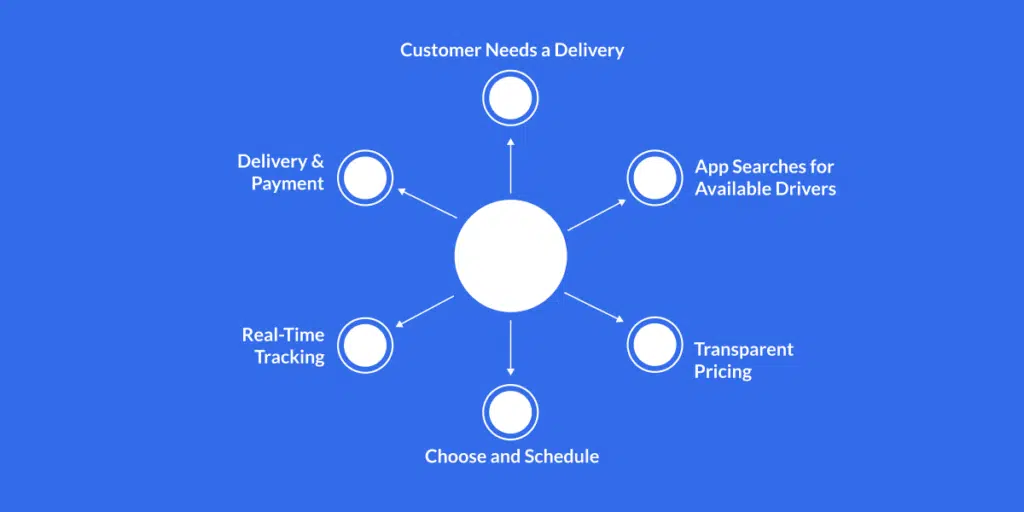
1. Customer Needs a Delivery
The process begins when a customer wants to send something. They open the app and enter important delivery details such as the size and weight of the item, where it needs to be picked up from, and where it should be delivered. This helps the app understand what kind of delivery service is needed.
2. App Searches for Available Drivers
Once the customer submits the request, the app automatically looks for drivers nearby. It checks which drivers are available and matches the job based on location and type of delivery. This step ensures that the delivery starts as soon as possible without delay.
3. Transparent Pricing
After the app finds available drivers, the app shows the delivery cost beforehand. The price is calculated based on the distance and the details of the package. This helps the customer see exactly how much they need to pay without any hidden fees. The clear pricing builds trust and helps customers decide quickly.
4. Choose and Schedule
Once the customer agrees with the price, they can choose a driver from the list and schedule the delivery. They can select the time for pickup, whether they want it done immediately or at a later time. With just a few taps, the details are confirmed, and the driver gets notified.
5. Real-Time Tracking
After the driver starts the delivery, the customer can see the driver’s live location on the map. The app shows how far the driver is and how long it will take for the delivery to be completed. This keeps the customer informed at every step of the journey.
6. Delivery & Payment
Once the item is delivered, the app sends a notification to the customer. The payment is made safely through the app using digital methods like UPI, card, or wallet. After the payment, the customer can also rate the service and leave feedback about their experience.
This simple step-by-step process helps users send their items quickly and with full confidence. If you create a logistics service app like Porter, make sure it includes all these essential features to offer a smooth and reliable delivery experience.
Why Do Business Owners Want to Develop a Logistics App Like Porter?
If you think, why to invest in a logistics app development, the answer is simple, because the logistics industry is rising with lots of growth opportunities. Apps like Porter have shown how powerful and profitable this model can be.
Have a look below at the key reasons why business owners are eager to develop a logistics service app like Porter.
1. A Growing Market
The logistics and delivery market is expanding rapidly. With more people shopping online and businesses relying on fast delivery services, the need for quick and reliable logistics apps has grown.
Customers today expect their goods to be delivered on the same day or even within hours. By choosing to build a logistics service app, entrepreneurs can tap into this rising demand and serve a wide audience.
2. Low Entry Barriers
An app based logistics business is easier to begin, unlike traditional logistics companies that require warehouses, fleets of trucks, and high capital investment.
Instead, you can create a logistics app like Porter that connects independent drivers with customers. With the help of a reliable mobile app development company, you can build the platform and start operations without heavy infrastructure costs. This flexibility attracts many entrepreneurs and small business owners who want to step into logistics without a huge budget.
3. High-Profit Margins
Another major reason why entrepreneurs are building logistics apps is the potential to earn high profits. These apps usually charge a delivery fee from the customer, and in some cases, also take a commission from the driver or vendor. Since the app handles multiple orders every day, the income adds up quickly.
When you develop a logistics service app like Porter with efficient systems and good pricing strategies, you can easily achieve a profitable business model. This makes the logistics app business not just sustainable, but highly rewarding in the long run.
4. Flexibility and Scalability
You can start with a few drivers in one city, and then slowly expand to other locations as demand increases. The same app can handle more deliveries, more customers, and even different types of services like bike delivery, mini trucks, or movers. This flexibility gives full control over how they want to scale their operations.
5. Technological Advancements
The app has various advanced features like GPS tracking, instant notifications, secure in-app payments, and AI-based route planning that make the user experience fast and easy. When business owners build a logistics service app with the latest tools and features, they offer better service, reduce delays, and improve customer satisfaction. Working with a skilled mobile app development company makes sure that your app stays updated with the latest trends and tools in the market.
How to Develop A Logistics App Like Porter?
There are the five important steps that will guide you through the complete process.
Whether you’re an aspiring entrepreneur or a growing business, these steps will help you to build a powerful and user-friendly logistics app.
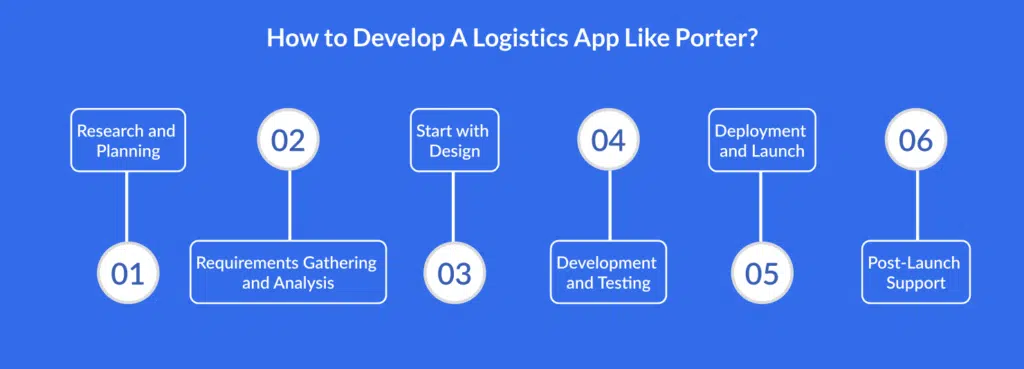
Step 1: Research and Planning
Start with understanding the logistics industry. Study the current market trends, your potential customers, and your competitors. This helps you figure out what features your app must have and how it can stand out from other similar apps.
You should also define your business goals. Decide what kind of services you want to offer, who your users are, and how you will make money. It should include your marketing strategies, estimated mobile app development cost, and long-term goals.
To make your idea a reality, look for a mobile app development company that has experience in building on-demand logistics and delivery apps. Their expertise will help you build a strong foundation.
Step 2: Requirements Gathering and Analysis
Once the planning is done, it’s time to get into the technical details. List out all the features you want in your app. These usually include real-time tracking, payment options, booking management, driver matching, and customer support.
You also need to decide the roles in your app, such as users, drivers, and admins. Each of them will have different levels of access and features.
Now, work closely with your chosen app development agency to build wireframes and user stories. Wireframes are simple layouts that show how the app screens will look. This step makes sure everyone understands the app’s flow and functions clearly.
Step 3: Start with Design
Design plays a major role in user experience. Your logistics app must be easy to use, clean, and visually appealing. At this stage, UI/UX designers start creating the actual look and feel of your app.
Work with the design team to ensure that the design matches your brand and meets the needs of your users. Keep it simple, and make sure users can find everything they need easily.
These are early versions of your app that users can click through. It helps you test how the app feels before actual development starts. You can collect feedback and make improvements at this stage to avoid costly changes later.
Step 4: Development and Testing
Once you are done with your designing part, your chosen warehouse management software development company or supply chain management software development company will begin writing the code and make your app live.
This includes backend development (the part that manages data and connections) and frontend development (what users see and use). Both iOS and Android versions are usually developed if you want to reach a wider audience.
Make sure the app includes all essential features such as real-time GPS tracking, in-app chat between driver and customer, online payments, booking and scheduling systems, and push notifications.
Once features are built, your app goes through several rounds of testing. This helps to check there are no bugs and everything works smoothly. Testing also checks if the app is easy to use and meets your business goals.
Step 5: Deployment and Launch
After successful testing, the app is ready to launch. First, set up cloud hosting, server infrastructure, and make sure the backend is fully prepared. Then, submit your app to the Google Play Store and Apple App Store.
Instead of launching it to everyone right away, do a soft launch first. Share the app with a small group of users and gather their feedback. This helps you fix any last-minute issues.
Once you’re confident everything is working perfectly, go ahead with the full launch.
Step 6: Post-Launch Support
When your app is live, it’s important to check it’s performance. Monitor user behavior, reviews, and ratings regularly.
Make sure your mobile app development company provides strong post-launch support. Fix any issues quickly, respond to user feedback, and keep updating your app to make it better.
Use analytics to understand what users like or dislike. Based on that, you can plan for future updates and add new features. This will help your app grow and remain competitive in the logistics market.
To develop a logistics service app like Porter, you need a clear roadmap, a reliable development partner, and a commitment to quality and user experience.
Key Features to Include in Your Logistic App
If you’re planning to develop a logistics service app like Porter, one of the most important things to focus on is the features. These features make your app useful, reliable, and user-friendly. You have to serve both users and service providers, so designing two separate panels, User’s Panel and Mover’s Panel is crucial.
What you should include in the User’s Panel?
User’s Panel Features
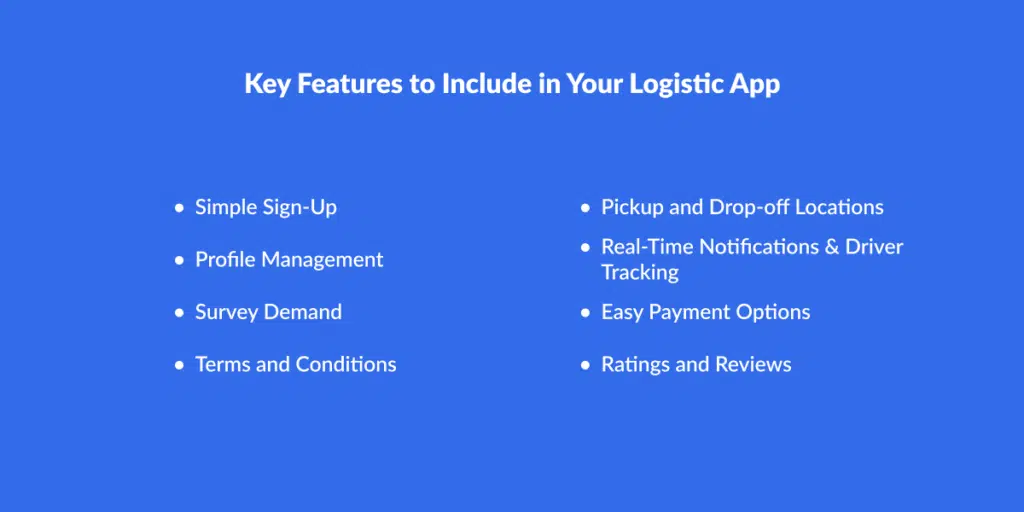
1. Simple Sign-Up
A quick and easy sign-up process, users should register using their mobile number, email, or social media. Keep it straightforward so users can instantly access the logistics services.
2. Profile Management
Allow users to create, edit, and manage their profiles easily. Include options to change contact details, add a profile picture, and adjust privacy settings.
3. Survey Demand
This feature enables users to request a survey before booking a service. They can mention what type of items they plan to move, helping movers prepare better.
4. Terms and Conditions
Before placing an order, users should view and agree to your app’s terms and conditions. This reduces future disputes and builds trust.
5. Pickup and Drop-off Locations
Users must be able to choose pickup and delivery addresses effortlessly. This ensures accurate service and a smooth experience.
6. Real-Time Notifications & Driver Tracking
Keep your users informed with notifications about their order status, dispatch updates, and estimated delivery time. Real-time driver tracking also adds transparency and boosts reliability.
7. Easy Payment Options
Offer multiple payment methods including UPI, credit/debit cards, and net banking. Integrate a fare calculator to help users estimate service costs before booking.
8. Ratings and Reviews
The app should have features for users to rate their experience and leave feedback. Positive reviews can boost your reputation, while suggestions can help you improve.
How Much Does It Cost to Create a Logistics App like Porter?
Wondering about the cost to develop an app like Porter?
The answer depends on several factors. Typically, the cost to build a logistics service app like Porter ranges from $10,000 to $60,000 or more, based on your requirements.
Key Factors That Influence the Mobile App Development Cost:
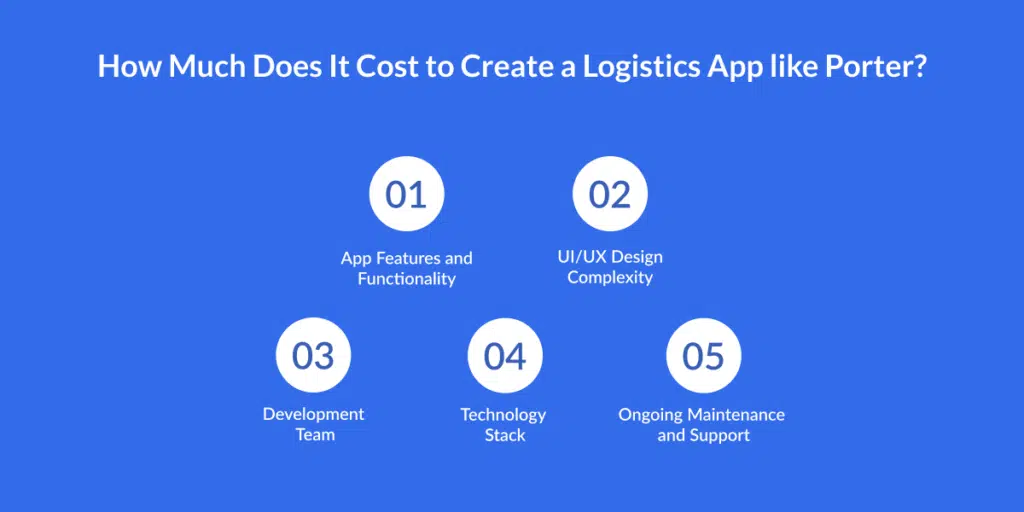
1. App Features and Functionality
Basic apps cost less. However, if you include features like GPS tracking, API integration, live chat, and payment systems, the price will rise.
2. UI/UX Design Complexity
Although a simple and easy-to-use design enhances the user experience, it also takes more time and effort, which affects the final cost.
3. Development Team
Hiring a skilled mobile app development company may seem costly but make sure better quality and timely delivery. Their experience with software development and API development adds value to your project.
4. Technology Stack
Choosing to build your app on iOS, Android, or both will affect the budget. Cross-platform development can also be an option to save time and cost.
5. Ongoing Maintenance and Support
Don’t forget post-launch support. Regular updates, bug fixes, and user support services are necessary and add to the cost.
Estimated Development Cost:
| Complexity | Development Time | Estimated Cost |
|---|---|---|
| Simple (Basic Features) | 3 - 6 Months | $10,000 - $25,000 |
| Moderate (Standard Features) | 6 - 12 Months | $25,000 – $45,000 |
| Complex (Advanced Features) | 12+ Months | $50,000+ |
How Do Logistic Apps Make Money?
When you develop a logistics service app like Porter, generating revenue from your app is very important for long-term success.
There are several easy ways to earn revenue.
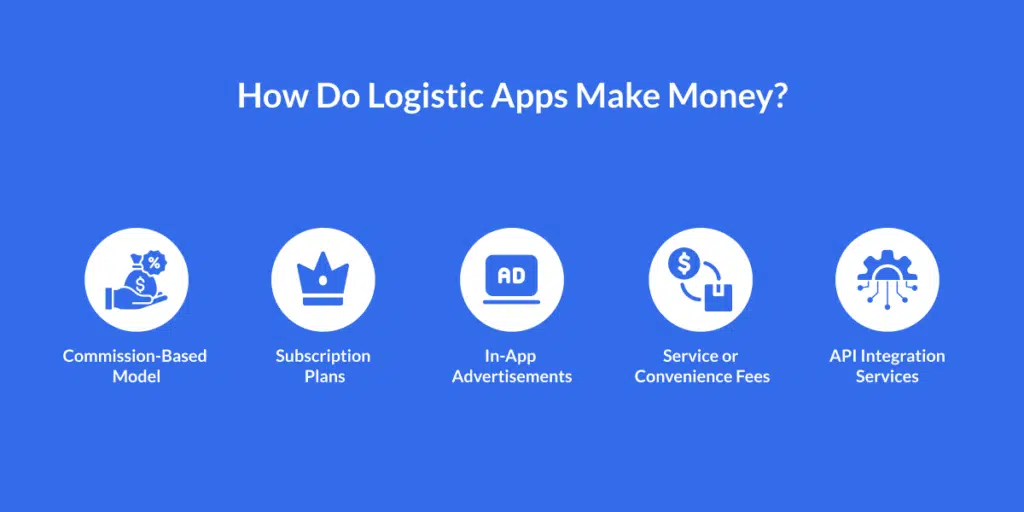
1. Commission-Based Model
This is one of the most popular ways to generate revenue. You can charge a small percentage from each order placed through your app.
For example, when a user books a truck or delivery service, you earn a commission from the service provider (the mover). This helps you gain profit on every booking made through the app.
2. Subscription Plans
You can offer special plans for regular users or businesses. These paid plans can include extra benefits like faster delivery, discounts, or access to premium features. This gives users more value, and you get monthly or yearly income.
3. In-App Advertisements
You can show ads from other businesses inside your app. These can be related to transport services, insurance companies, packing material sellers, etc. The more users you have, the more you can earn through ads.
4. Service or Convenience Fees
Charge users a small extra fee during checkout. This fee can cover things like customer support, admin charges, or app maintenance. It’s a small amount for users but adds up to a good profit for you.
5. API Integration Services
If you have your own software or tools (like live tracking or billing systems), you can offer them to other companies. You provide access to these tools through APIs and charge them for using it. This is a great way to gain revenue by helping other apps or platforms grow.
Whether you develop a logistics service app like Porter or any other transport app, choosing the right revenue model will help your business grow and earn profit.
Future Trends and Predictions for Logistics Apps Like Porter
Before you start to develop a logistics service app like Porter, it’s important to understand how fast the logistics industry is changing.
New technologies and customer demands are reshaping the future. Below are some key trends and forecasts that will impact logistics apps in the coming years:
1. Market Growth and Expansion
The logistics app market is growing very fast. According to Markets And Markets research, from 2020 to till 2025, it’s expected to grow at a rate of 21.7% each year. By 2025, it may reach a total value of $46.5 billion. Apps like Porter are focusing more on last-mile deliveries, and this area alone could reach $200 billion by 2027. This shows how profitable it can be to build a logistics service app today.
2. AI and Machine Learning Integration
Artificial Intelligence (AI) is improving logistics in many ways. It helps with customer support, predicting demand, and choosing better delivery routes. AI can reduce delivery time mistakes by 30%. These smart features make your app more accurate and user-friendly.
3. Autonomous and Electric Vehicles
Self-driving vehicles are the future of city transportation. By 2030, 40% of city-based transport could be fully driverless. Also, electric delivery vans will become more popular. About 35% of new light delivery vehicles sold by 2030 will be electric. These changes will reduce delivery costs and help the environment.
4. IoT and Real-Time Tracking
The Internet of Things (IoT) is becoming a key part of logistics. It will help companies track deliveries in real time. By 2026, IoT is expected to generate $63 billion for the logistics industry. And it will help in tracking all deliveries in real-time. This boosts transparency and keeps customers informed at every step.
5. Eco-Friendly Transportation Solutions
Customers today want eco-friendly services. The market for green logistics is expected to reach $1.3 trillion in 2022 and is projected to reach $2.9 trillion by 2032,. Apps like Porter will soon offer carbon-neutral delivery as a standard feature. If you’re planning to develop a logistics service app like Porter, adding eco-conscious options can make your app more attractive.
6. Part-Time Delivery Jobs and Local Helpers
More people are working as freelance or part-time delivery agents. By the end of 2025, this model is expected to reach 1.1 billion. This system is flexible and cost-effective.
7. Blockchain for Open Supply Chains
Blockchain is becoming important for transparency in supply chains. In 2025, many large supermarkets will use blockchain to track goods and ensure product safety. If you’re working with a mobile app development company, make sure they can handle blockchain integration during software development.
Conclusion
Logistics apps like Porter are not just changing how goods are moved, but they are also changing the future of transportation and delivery.
As the industry continues to grow, new opportunities for new businesses and startups are also increasing. Whether you’re looking to develop a logistics service app from scratch or upgrade your existing system, staying informed about market trends and technologies is the key to success.
Investing in the right features, modern technologies, and a trusted mobile app development company will help you create a powerful, profitable app.
FAQs
Q1. How much does it cost to create a logistics app like Porter?
A: The cost usually ranges from $10,000 to $60,000 or more, depending on the features, platform, design, and development team you choose.
Q2. What are the key features of a logistics app?
A: Important features include user registration, real-time tracking, multiple payment options, notifications, order history, driver information, and customer ratings.
Q3. How do I earn money from a logistics app?
A: You can earn through commission on bookings, subscription plans, service fees, ads, and API integrations with third-party platforms.
Q4. Is API development necessary for logistics apps?
A: Yes. API development allows your app to connect with other platforms, payment systems, and real-time tracking tools, making it more functional and scalable.
Q5. Which technologies are used in logistics app development?
A: Technologies like AI, IoT, Blockchain, AR, and cloud-based systems are commonly used to improve efficiency and performance.

RM Mishra
Co-Founder
Developer Bazaar technologies






